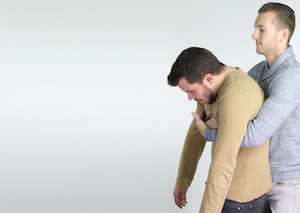 The Journal of Emergency Medicine first published an account of the Heimlich manoeuvre in 1974. Since then, it has been used to assist people when they are choking, helping to forcefully eject any foreign object which is preventing breathing.
The Journal of Emergency Medicine first published an account of the Heimlich manoeuvre in 1974. Since then, it has been used to assist people when they are choking, helping to forcefully eject any foreign object which is preventing breathing.
Choking is potentially life threatening. It occurs when something blocks the airway or throat – food is often a culprit, but toys and other objects also cause choking.
Without oxygen entering the lungs, brain damage can occur in as little as four minutes, so rapid first aid for choking, such as the Heimlich manoeuvre can save a person’s life.
It is very important to follow the following guidelines:
- One of the indications of choking is silence – if the airway is entirely blocked, sound can barely escape.
- However you MUST ask, “Are you choking? Can you speak?”
- DO NOT perform first aid if the person is coughing forcefully and is able to speak. A strong cough can often dislodge the object.
- The person must be choking and conscious – never practice on someone who is not.
- It is not recommended for infants under a year old.
If the person is choking, perform the manoeuvre as follows:
- If the person is sitting or standing, position yourself behind the person and reach your arms around his or her waist. For a child, you may have to kneel.
- Place your fist, thumb side in, just above the person’s navel (belly button).
- Grasp the fist tightly with your other hand.
- Make quick, upward and inward thrusts with your fist.
- If the person is lying on his or her back, straddle the person facing the head. Push your grasped fist upward and inward in a movement similar to the one above.
You may need to repeat the procedure several times before the object is dislodged. If repeated attempts do not free the airway, call 111.
If the person loses consciousness, start CPR.
If you see something blocking the airway and it is loose, DO NOT try to remove it. If the object is lodged in the person’s throat, do NOT try to grasp it. This can push the object farther into the airway.
If you are not comfortable performing abdominal thrusts, you can perform back blows instead on a person who is choking.
To perform back blows:
- Stand behind the person. For a child, you may have to kneel.
- Wrap one arm around to support the person’s upper body. Lean the person forward until the chest is about parallel to the ground.
- Use the heel of your other hand to deliver a firm blow between the person’s shoulder blades.
- Check if the object is dislodged.
- Continue back blows until the object is dislodged or the person loses consciousness
After the object is successfully dislodged, the person should see a doctor because complications can arise. In the days following a choking episode, contact a doctor right away if the person develops:
- A cough that does not go away
- Pneumonia and fever
- Shortness of breath
- Wheezing
These could be signs that the object entered the lung instead of being expelled.









Join the Discussion
Type out your comment here:
You must be logged in to post a comment.